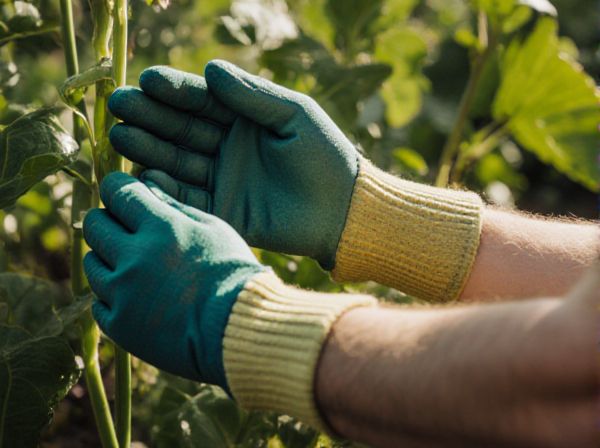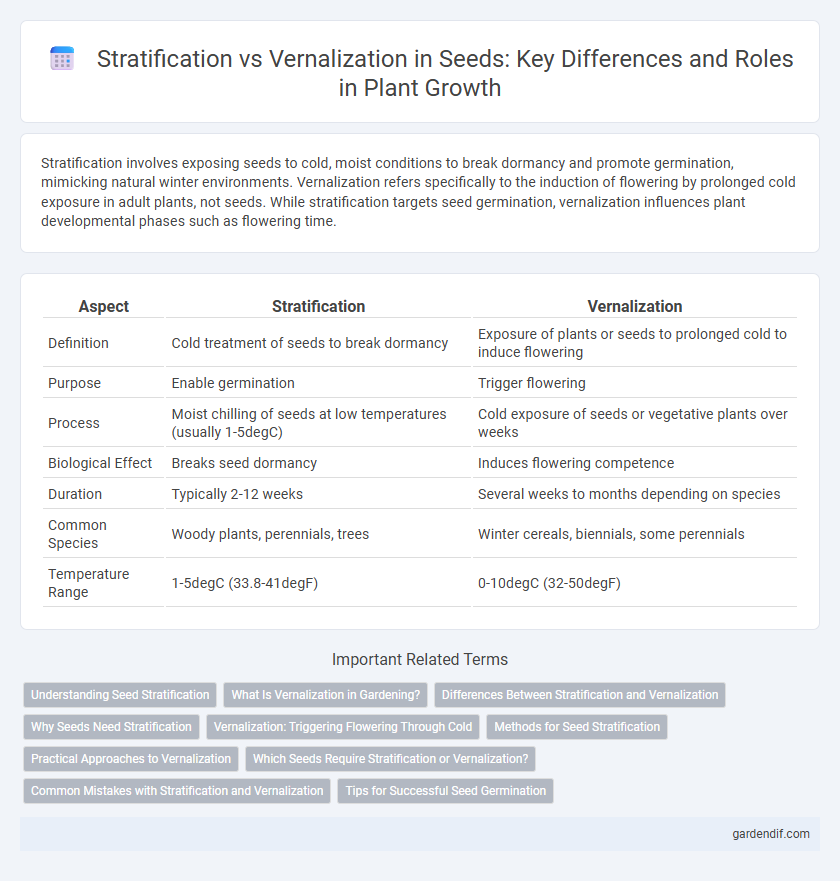
Stratification vs Vernalization Illustration
Stratification involves exposing seeds to cold, moist conditions to break dormancy and promote germination, mimicking natural winter environments. Vernalization refers specifically to the induction of flowering by prolonged cold exposure in adult plants, not seeds. While stratification targets seed germination, vernalization influences plant developmental phases such as flowering time.
Table of Comparison
| Aspect | Stratification | Vernalization |
|---|---|---|
| Definition | Cold treatment of seeds to break dormancy | Exposure of plants or seeds to prolonged cold to induce flowering |
| Purpose | Enable germination | Trigger flowering |
| Process | Moist chilling of seeds at low temperatures (usually 1-5degC) | Cold exposure of seeds or vegetative plants over weeks |
| Biological Effect | Breaks seed dormancy | Induces flowering competence |
| Duration | Typically 2-12 weeks | Several weeks to months depending on species |
| Common Species | Woody plants, perennials, trees | Winter cereals, biennials, some perennials |
| Temperature Range | 1-5degC (33.8-41degF) | 0-10degC (32-50degF) |
Understanding Seed Stratification
Seed stratification is a pre-germination treatment that mimics natural winter conditions by exposing seeds to cold and moist environments, breaking seed dormancy and enhancing germination rates for species such as apples and cherries. Vernalization differs by requiring prolonged cold exposure primarily to induce flowering in plants rather than affecting seed germination directly. Understanding seed stratification is crucial for optimizing propagation protocols and improving seedling uniformity in horticulture and forestry.
What Is Vernalization in Gardening?
Vernalization in gardening refers to the process of exposing seeds or young plants to prolonged cold temperatures to induce flowering or germination. This cold treatment mimics winter conditions, breaking seed dormancy and triggering physiological changes essential for timely development. Understanding vernalization helps gardeners optimize planting schedules for crops like wheat, carrots, and biennials that require this cold phase for successful growth.
Differences Between Stratification and Vernalization
Stratification involves exposing seeds to cold, moist conditions to break dormancy and mimic natural winter environments, while vernalization requires prolonged cold exposure of the plant or seed to trigger flowering rather than germination. The primary difference lies in stratification preparing seeds for germination, whereas vernalization promotes flowering by inducing physiological changes after cold treatment. Stratification typically occurs in the soil or moist substrate, and vernalization is often a requirement for biennial or winter annual plants to transition from vegetative to reproductive phases.
Why Seeds Need Stratification
Seeds require stratification to break dormancy by mimicking natural winter conditions through cold and moist treatment, ensuring uniform germination. Unlike vernalization, which promotes flowering by exposing plants or seeds to prolonged cold, stratification specifically prepares seeds to overcome physiological barriers that prevent sprouting. This process enhances seedling establishment and improves crop yields in species with innate dormancy mechanisms.
Vernalization: Triggering Flowering Through Cold
Vernalization is a critical process in seed biology where prolonged exposure to cold temperatures triggers flowering in many plant species, ensuring reproductive success in favorable conditions. This cold-induced mechanism alters gene expression, breaking seed dormancy and synchronizing flowering time with seasonal changes. Compared to stratification, which primarily breaks seed dormancy through moisture and temperature fluctuations, vernalization specifically prepares the plant for flowering by modifying developmental pathways.
Methods for Seed Stratification
Seed stratification involves exposing seeds to specific cold, moist conditions to simulate natural winter environments, promoting germination by breaking seed dormancy. Common methods for seed stratification include cold moist stratification, where seeds are mixed with moist media like sand or peat and stored at temperatures between 1-5degC for several weeks to months, and warm moist stratification, applied before cold treatment for certain species. These controlled environmental techniques optimize germination rates in species such as apple, cherry, and maple by mimicking seasonal temperature fluctuations.
Practical Approaches to Vernalization
Vernalization involves exposing seeds to prolonged cold temperatures, typically between 0degC and 10degC, to induce flowering in plants with a winter growth cycle. Practical approaches to vernalization often include storing seeds in a refrigerated environment or sowing them outdoors during autumn to naturally experience the necessary chilling period. This controlled cold exposure differs from stratification, which primarily aims to break seed dormancy through moisture and temperature cues, making vernalization essential for species requiring cold-induced flowering.
Which Seeds Require Stratification or Vernalization?
Seeds of temperate-climate perennials such as apple, cherry, and many wildflowers require stratification, a cold, moist treatment to break dormancy and promote germination. Vernalization typically applies to certain biennial and perennial plants like winter wheat and spinach, where exposure to prolonged cold induces flowering rather than seed germination. Understanding whether a seed needs stratification or vernalization depends on its species-specific dormancy mechanisms and growth cycle adaptations.
Common Mistakes with Stratification and Vernalization
Stratification commonly suffers from errors like improper temperature control, leading to ineffective seed dormancy breaking, while vernalization mistakes often involve insufficient cold exposure duration, resulting in delayed or failed flowering. Misunderstanding species-specific requirements for stratification or vernalization can cause seed germination failures and reduced crop yields. Accurate monitoring of temperature and exposure time is critical for optimizing seed dormancy release and triggering appropriate developmental phases.
Tips for Successful Seed Germination
Stratification involves exposing seeds to moist, cold conditions that mimic winter, triggering physiological changes essential for breaking dormancy and promoting germination in temperate species. Vernalization refers to the prolonged cold treatment necessary for certain seeds to initiate flowering after germination, typically impacting cereal grains and biennials rather than seed germination itself. For successful seed germination, maintain optimal moisture levels during stratification, use appropriate temperature ranges between 1-5degC, and ensure the seed type's specific dormancy requirements are met to improve germination rates.
Stratification vs Vernalization Infographic

 gardendif.com
gardendif.com